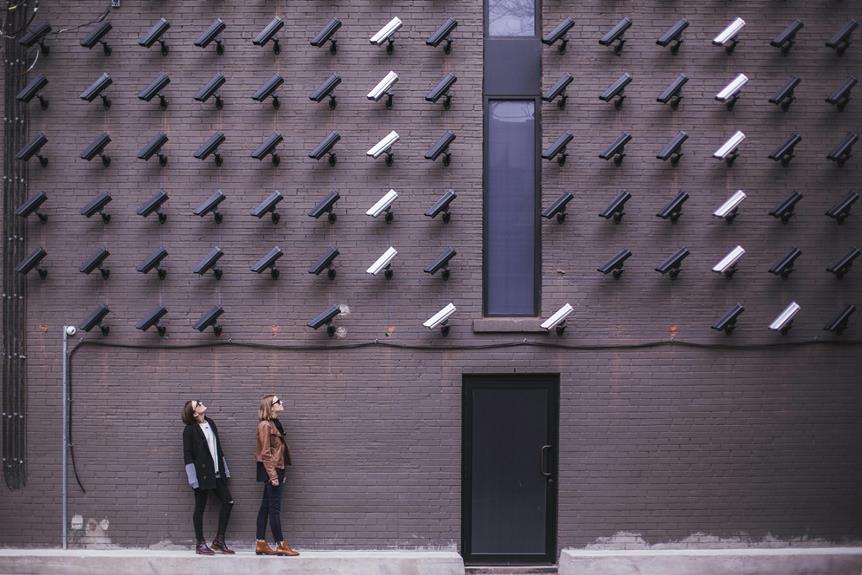Socket security cameras feature innovative designs by combining advanced technology with user-friendly features. These cameras excel in wireless connectivity, durability against harsh weather, and simple installation processes. They offer enhanced security with motion tracking, providing accurate monitoring and object/people tracking. Camera resolution options provide detailed images and zoom capabilities, although higher resolutions might necessitate more storage. While socket cameras offer easy installation, affordability, and remote access, privacy and security risks should be considered. Their night vision capabilities guarantee 24/7 monitoring and deter intruders with infrared illumination. Learn more about how these features can benefit your surveillance needs.
In a Nutshell
Socket cameras are known for their innovative design features, making installation easy and cost-effective. They also offer remote access and seamless integration with smart home systems, enhancing convenience and control for users. However, it's important to note that privacy concerns and data security risks are potential drawbacks of using socket security cameras. Additionally, legal compliance issues may arise due to the use of these cameras, requiring careful consideration. While socket cameras provide some useful features, they may have limitations when compared to other security camera options.
Unique Camera Specifications
When setting up your socket security cameras, it's important to carefully examine the unique specifications to optimize their performance. The wireless connectivity options allow for seamless remote monitoring features, enabling you to keep an eye on your property from anywhere. However, some cameras may have limited range or connectivity issues that could impact the reliability of the remote monitoring feature.
Checking the camera durability is crucial for long-lasting protection against harsh weather conditions or potential tampering. A durable camera can withstand various environmental factors, ensuring continuous surveillance. On the downside, some cameras may not be as durable and could be vulnerable to damage, reducing their effectiveness in providing security.
Guaranteeing a smooth installation process is essential to make the most of your security system. A simple and user-friendly installation can save time and effort, allowing you to set up the cameras quickly and efficiently. Nonetheless, complex installation requirements or lack of clear instructions could lead to difficulties in setting up the cameras effectively.
Camera Motion Tracking Technology
Enhance your surveillance capabilities with advanced Camera Motion Tracking Technology.
- Enhanced Monitoring: Tracks movement accurately, providing detailed insights into activities.
- Heightened Security: Notifies you of suspicious activity promptly, ensuring a proactive approach to security.
- Ease: Effortlessly track objects or people, simplifying the monitoring process.
- Compatibility: Regular software updates guarantee peak performance, but may require regular maintenance for optimal functionality.
- Privacy Concerns: Addressing privacy concerns, ensuring data protection and compliance, but potential vulnerabilities may arise if not properly secured.
Camera Resolution Quality
To ensure optimal monitoring clarity, it's crucial to select a camera with a resolution that aligns with your surveillance requirements. When evaluating image clarity and resolution, consider the following factors:
Positive Points:
Claim Upto 81% Off On Bestseller Home Decor Products
- Opt for a minimum of 1080p resolution to capture detailed images with enhanced clarity.
- Higher resolution cameras offer superior zoom capabilities, allowing you to focus on specific areas with precision.
- Comparing different resolutions enables you to choose the best option tailored to your monitoring needs.
Negative Points:
- Higher resolution cameras may require more storage space for recordings, potentially leading to increased storage costs.
- Cameras with ultra-high resolutions may not be necessary for all surveillance scenarios, leading to unnecessary expenses.
Drawbacks of Socket Cameras
Socket security cameras offer several benefits and drawbacks that users should consider before investing in them. Here are some key factors to keep in mind:
Pros:
- Easy installation: Socket cameras are typically easy to install and set up, making them a convenient choice for users.
- Affordability: These cameras are often more budget-friendly compared to other security camera options, making them a cost-effective solution for home monitoring.
- Remote access: Users can often access the camera feed remotely, allowing them to monitor their property from anywhere using a smartphone or computer.
- Integration with smart home systems: Socket cameras can be integrated with smart home systems, enabling users to automate security alerts and actions.
Cons:
- Privacy concerns: Socket cameras can raise privacy concerns as they may capture sensitive information or invade personal spaces.
- Data security risks: Securing the footage captured by socket cameras and preventing unauthorized access to it can be a challenge, posing potential data security risks.
- Legal compliance: Users must ensure that they comply with surveillance laws and regulations when using socket cameras to avoid legal repercussions.
- Limited features: Some socket cameras may have limited features compared to more advanced security camera systems, which may impact their effectiveness in certain situations.
Camera's Night Vision Capability
When it comes to evaluating a security camera's night vision capability, understanding the fundamentals of night vision technology is essential.
Night vision technology relies on infrared light to capture images in the dark, with varying degrees of success depending on the quality of the camera's infrared LEDs.
The effectiveness of infrared illumination plays a significant role in how well a security camera can see in low-light conditions.
Night Vision Technology Overview
Enhance your knowledge of the night vision capability of socket security cameras with this comprehensive overview. These cameras employ either infrared sensors or thermal imaging technology to capture images in low-light conditions. Infrared sensors are adept at detecting heat signatures and converting them into visible images, while thermal imaging is proficient at detecting temperature variations. Understanding these technologies will empower you to make informed decisions when selecting a socket security camera for your home or business.
Positive points:
- Enhanced Visibility: Socket security cameras with night vision capabilities provide clear and detailed images even in low-light or pitch-dark conditions.
- Increased Security: The ability to capture images in the dark enhances the security of your property, allowing you to monitor and record activities around the clock.
- Deterrent to Intruders: The presence of night vision cameras can act as a deterrent to potential intruders, reducing the risk of break-ins and theft.
- Remote Monitoring: You can remotely access and monitor the camera feed even in low-light conditions, offering peace of mind and convenience.
Negative points:
- Limited Range: Some socket security cameras may have a limited range of night vision, affecting their effectiveness in capturing images at longer distances.
- Potential Glare: Infrared sensors may sometimes produce glare or reflections, which can distort the quality of the images captured in certain lighting conditions.
- Higher Cost: Cameras with advanced night vision technology, such as thermal imaging, may come at a higher cost compared to standard cameras without this feature.
- Power Consumption: Night vision cameras may consume more power when operating in low-light conditions, potentially leading to higher electricity bills.
Infrared Illumination Effectiveness
When evaluating the effectiveness of infrared illumination in improving a camera's night vision, it's important to consider both the advantages and limitations it presents. The clarity and range of visibility provided in low-light conditions are key factors to assess.
Positive points:
- Enhanced visibility: Infrared illumination helps the camera capture clear images even in complete darkness, allowing for effective surveillance during nighttime.
- Extended range: The infrared range enables the camera to see farther distances in low-light environments, enhancing overall monitoring capabilities.
Negative points:
- Limited color accuracy: Infrared illumination can distort colors, resulting in black and white images, which may not accurately represent the true colors of objects or individuals.
- Glare and reflections: In some instances, infrared illumination can cause glare or reflections, potentially hindering the camera's ability to capture clear footage in certain conditions.
Understanding both the benefits and drawbacks of infrared illumination can help in making informed decisions regarding the camera's suitability for different security needs and environments.
Low-Light Performance Comparison
Assessing the low-light performance of socket security cameras entails comparing their night vision capabilities to ascertain their ability to capture clear images in dark conditions effectively. The quality of images produced in low-light scenarios varies across cameras, influencing the visibility of details.
Some cameras excel in providing sharp and crisp images even in complete darkness, ensuring a high level of security. On the other hand, certain cameras may struggle in low-light conditions, resulting in grainy or blurry footage that hampers visibility and identification.
Moreover, it's essential to consider the power consumption required for night vision, as some cameras may consume more energy to maintain visibility, leading to higher operational costs in the long run. Balancing performance with energy efficiency is crucial in choosing a socket security camera that meets both image quality and cost-effective operation requirements.
User Satisfaction Levels
Users generally express high levels of satisfaction with socket security cameras due to their ease of installation and reliability. The seamless user experience provided by these cameras contributes substantially to their positive feedback. Users appreciate the straightforward setup process and the consistent performance that these cameras offer.
However, some users have reported issues with connectivity and occasional lag in live streaming, which can be frustrating. Despite these drawbacks, the overall product reliability is a key factor influencing user satisfaction levels, ensuring peace of mind and a sense of security.
Value for Socket Cameras?
Socket security cameras offer a good value proposition for users looking for a cost-effective surveillance solution. On the positive side, they're budget-friendly and provide decent quality for their price point. The straightforward installation process makes them accessible to users without technical knowledge, adding to their appeal.
However, on the downside, some socket cameras may lack advanced features found in higher-end models, limiting their functionality for more specific surveillance needs. Additionally, the video quality and night vision capabilities of these cameras may not be as high as more expensive options on the market.
Despite these limitations, socket security cameras remain a practical choice for those on a budget looking to bolster their home security.
User Feedback on Cameras
Customer feedback is crucial in evaluating the performance and reliability of socket security cameras. Many customers appreciate the easy installation process, noting the user-friendly setup that enables quick and hassle-free deployment. The smooth installation experience is often highlighted in reviews, contributing to the positive reception of socket security cameras.
However, some customers have raised concerns about the durability of the cameras over time and have experienced issues with connectivity or software updates. It's important to consider both the positive and negative points in customer feedback to make an informed decision about socket security cameras.
Frequently Asked Questions
Are Socket Security Cameras Compatible With Smart Home Devices Such as Alexa or Google Home?
Yes, socket security cameras can be voice-controlled with smart home devices like Alexa or Google Home. However, some compatibility issues may arise, so make sure your devices are updated and compatible for a seamless experience.
How Does the Camera Handle Outdoor Weather Conditions Like Rain or Snow?
When it comes to weather durability, Socket Security Cameras are designed to withstand rain and snow, ensuring reliable outdoor performance. The installation process is straightforward, making it easy for you to set up and protect your home.
Can Socket Security Cameras Be Integrated With Existing Home Security Systems?
Yes, you can integrate Socket Security Cameras with existing home security systems. There are various integration options available, but some technical challenges may arise. Consider cost comparison and the installation process when incorporating these cameras into your setup.
What Is the Average Lifespan of a Socket Security Camera?
On average, the lifespan of a socket security camera ranges from 3 to 5 years. Factors like environmental conditions can affect longevity. Check warranty coverage for replacement options. Consider where you place it for best performance and durability.
Are There Any Privacy Concerns With Using Socket Security Cameras in a Home Setting?
When utilizing socket security cameras at home, it is important to remain conscious of potential privacy concerns. Activate data encryption to safeguard your privacy. Refrain from remote access unless essential to reduce surveillance risks and protect your personal information.


